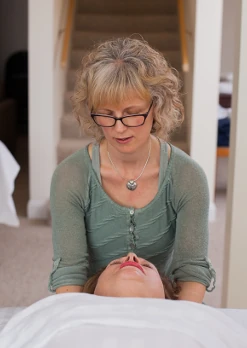How Rosen Method Bodywork Supports Self-actualization
Monday, May 01, 2017, 02:45 PM
The Journey from Trauma into Well-being
What is Rosen Method?
Rosen Method Bodywork is a full-body treatment that uses gentle, non-manipulative touch and words to help clients drop into body awareness, allowing them to access the body's unconscious.
The practitioner will place their hands on an area of the body that needs release, offering physical support to allow the muscles to experience the possibility of surrender from within.

Cinnamon Cranston is a Rosen Method Bodywork practitioner, registered massage therapist, and Reiki practitioner. Cinnamon found Rosen Method after undergoing eight years of therapy for Post-Traumatic Stress Disorder.
She explains that while she felt psychologically healthy, in moments she felt as though her body was expressing a deeper need to heal.
"The first time I experienced Rosen I knew that was how I wanted to work with the body," said Cinnamon. "I was drawn to the pure form of communication between the client and practitioner. The practice has no agenda for where a person should go or what they should experience during treatment."
Cinnamon describes Rosen as finding the way out of trauma and survival mode and into safety and well-being. "As practitioners we support individuals to come into their own bodies and heal themselves through increased awareness and understanding."
Rosen Method is the marriage of a strong knowledge base and intuition. Cinnamon uses her understanding of the breath and nervous system to connect to her client's essence, which she describes as the core of who we are.
Our essence exists in our nervous system, our cells and our entire bodies. Our connection to it gives us a sense of vitality and well-being. However, when we experience trauma or incredible stress, our bodies click into survival mode; if proper support is not available to aid in recovery, we become disconnected from our bodies.
Emotions, needs, and impulses that were repressed by the body at the time become "unconscious" to us. In this way, Rosen Method Bodywork helps to accesses the unconscious through touch.
Who Can Benefit from Rosen Method?
When asked if Rosen Method treatment is for everyone, Cinnamon says a person must be in a place where they are willing to open up and explore their core self in order to benefit from the practice.
Often clients are not looking to heal from a specific issue, but are rather looking to reach their full capacity by releasing self-limiting behaviours.
"Some people aren't in a place where they are ready to let go," explains Cinnamon. "They may need walls and defenses in order to feel protected and safe. In Rosen we respect that people are doing exactly what is right for them at that moment."
First-time Experience
Garrett, who recently experienced his first Rosen Method treatment with Cinnamon, says he was unsure what to expect and was apprehensive at first.
"Within about ten minutes I could feel myself begin to relax and let go," says Garrett. "I trusted Cinnamon to allow emotions and past experiences to surface without pushing me to an uncomfortable place or forcing me to talk about what I was feeling."
A Rosen Method Practitioner will stress that it is not important for them to know what the client has experienced or remembered; rather, it is important for the client to recognize and find understanding in those experiences.
Garrett believes it was the understanding that he could take the time he needed to fully let go, and be unconditionally supported in that experience, that allowed him to trust Cinnamon so quickly.
The surrender into trust allowed Garrett to release his apprehension and find meaning and acceptance in experiences and feelings from his past.
A Rosen Method Treatment
A typical session is 60 minutes. The client and practitioner will meet prior to starting the session to discuss any health conditions, injuries, and emotional or physical trauma. This allows the practitioner to have a sense of where to begin working.
The client will lie on a massage-type table, without the use of a face cradle, as practitioners closely watch the client's facial expressions to help guide the treatment.
The client can choose to remove clothing down to their underwear or remain fully clothed depending on comfort level. The client is then covered with a sheet. Half of the session is conducted with the client lying on their stomach, and the other half with the client on their back.
With permission, the practitioner will lightly place their hands on the client and adjust pressure and placement using subtle changes in breath and muscle tension as a guide.
After the session is over the client and practitioner will discuss the session and the next steps the client should take. A minimum of three sessions is recommended to allow the body to learn the language of Rosen Method.
Interested?
For more information on Rosen Method Bodywork treatments and techniques, training opportunities, or to find a practitioner, see the Holistic Health Guide, the NHPC Member Directory, or the Rosen Method Institute of Canada.
About Cinnamon

Cinnamon Cranston is the co-owner of the Rosen Method Institute of Canada. She has been in the health and wellness field for over 20 years and has practised Rosen Method for almost nine years, including training. All Rosen Method practitioners undergo three and a half years of tracking and training and present 350 client hours before becoming registered. Rosen Method Bodywork is recognized by the Natural Health Practitioners of Canada.

